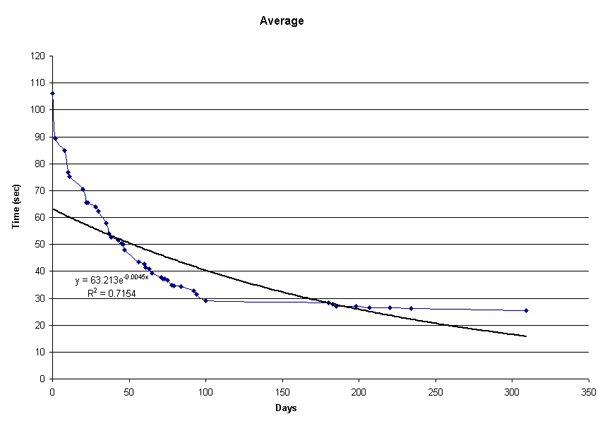The Rubik's Cube
About my cube - I started solving in January of 2005. I averaged under 30 seconds exactly 100 days after my first average. I started with Petrus, but found it to be very hard to get going at a decent speed with. So, after a couple of weeks I switched to Gilles Roux's method. I currently use a Rubik's DIY cube with arched centers and screws. I use stickers from www.cubesmith.com. I suggest you do the same. Rubik's stickers last me about a week, and I've been using the same set of cubesmith stickers for over six months and they still look great!Progress Excel sheet

You can see that as soon as I got under 30 seconds I actually took a 3 month break to work on my bowling and some other projects, and just decided to pick it back up after those three months, and almost immediately I was getting new averages. So maybe the break helped. My Full Cube Log
Best Average: 24.09 - [2/20/2007]
Best Single Solve: 18.05 - [2/20/2007]
Best Lucky Solve: 18.42 - [9/29/2005]
I also love the FMC even though I haven't done a lot of them. Here is my FMC Page where I put my solutions and some of the ways I attempt to solve the cube. Sune - [12/1/05] - This is probably the most common algorithm used on the rubik's cube. In fact, you can solve the cube with only two and this is one of them. After working with it for awhile this is the fastest way that I have found to do this while not having to move my hand out of the side position.(very important with Roux method for speed)
The first shows about how I do it in slow motion and the second at normal speed. I actually do 7 moves in a little less than 1.2 seconds. And I accidently paused while doing it. =) Solve Videos - Just some videos.
| 22.52 Solve - [12/13/05] | 24.57 Penalty Solve - [12/13/05] | 26.88 Second Solve - [12/1/05] |
| This was a decent solve. I'm still locking up quite a bit which really hurts my time. | I got a little jumpy at the end but it was a fun solve anyway. | This was a little slow, and if I could just not spend so much time looking I'd be pretty fast. |
I also built in a sequence solver because I thought it was really neat and the program I was using didn't have anything like it. You enter in any algorithm you want and it tells you how many times that algorithm has to run in order to get back to a solved cube. For instance L F U has to be repeated 80 times before you get back to a solved cube. neat.
Instructions
Cube Program
|
Main Menu Solving Menu Solutions Sequence |

|
|
Size Screen Diagonal Straight |

|